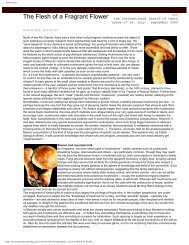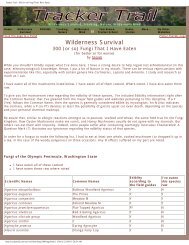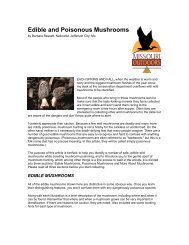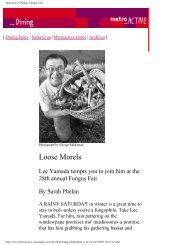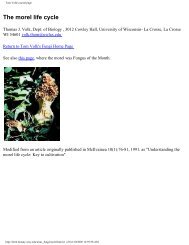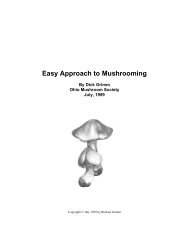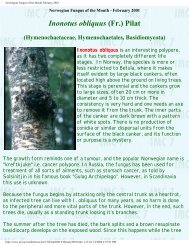Wild Mushroom Hunting - Missouri Mycological Society
Wild Mushroom Hunting - Missouri Mycological Society
Wild Mushroom Hunting - Missouri Mycological Society
You also want an ePaper? Increase the reach of your titles
YUMPU automatically turns print PDFs into web optimized ePapers that Google loves.
<strong>Wild</strong> <strong>Mushroom</strong> <strong>Hunting</strong><br />
Feature Article<br />
<strong>Wild</strong> <strong>Mushroom</strong> <strong>Hunting</strong><br />
DECEMBER 2004<br />
Subscribe<br />
Inside This Issue<br />
Just Released!!<br />
The Black Trumpet, Craterellus fallax, blends into the shadows, making it difficult to find.<br />
It grows alone or in groups under hardwoods, and its thin flesh has a strong, fruity fragrance.<br />
Download this article as a PDF file (402K). Requires Adobe Acrobat Reader.<br />
Right-click on link and save file to your hard drive.<br />
WILD MUSHROOM HUNTING<br />
THE LURE AND LORE<br />
By Kathleen Kerr<br />
MUSHROOMS HAVE ALWAYS been a portal between this world and another, a realm of mystery<br />
and intrigue. Fairies came to dance in their rings. Sorcerers used them in their potions. Some actually<br />
glow in the dark, the phenomenon known as “foxfire.”<br />
Today, many of us drawn to wild mushroom hunting enter this shadowland sport through culinary<br />
desire rather than myth and legend, though there are many fascinated by the lore. We begin with the<br />
smoky, earthy flavor of spring morels. But then, with a curious palate, a keener eye for spotting fungi,<br />
and nature prompting us, we explore other choice mushrooms of all shapes, sizes, and colors that<br />
primarily fruit in <strong>Missouri</strong>’s mid- to late summer and fall.<br />
With so many more species on our list, the fervor of the hunt can be even better than a spring morel<br />
http://www.missourilife.com/feat001.shtml (1 of 13)11/28/2004 7:19:41 AM
<strong>Wild</strong> <strong>Mushroom</strong> <strong>Hunting</strong><br />
hunt. Finding a bright-orange chicken of the woods layered and painted on an oak tree is much like<br />
landing a trophy trout. With the zeal of our first choice catch, we pass into the subculture of the<br />
mushroom people.<br />
MUSHROOM PEOPLE<br />
It’s not clear how or who passes over to the mushroom people, the land of mycophiles, us funguslovers.<br />
Some mushroomers, such as Leon Shernoff, editor of <strong>Mushroom</strong>, The Journal of <strong>Wild</strong><br />
<strong>Mushroom</strong>ing, believe the call lies within our past.<br />
“My father likes to say that we were all hunter-gatherers at one point, so we all have a deep need to<br />
get out in the woods and fish, hunt mushrooms, game, or collect wild plants,” Leon says. “It really<br />
does awaken something primeval within us — even nonmushrooming friends who come along on a<br />
mushroom walk have told me that it completely changes the way that they see the woods.”<br />
Along with the innate drive to hunt and gather, something strange seems to take over mushroom<br />
people, an enthusiasm for fungi that knows no bounds. For example, you can listen to the CD Fungal<br />
Boogie, a tribute to various fungi by Zoe Wood, a songwriter and guitarist, and Larry Evans, a fungal<br />
ecology consultant and mushroom peddler.<br />
It’s a mix of blues, country and western, rock ’n’ roll, waltz, and polka. Here are some sample lyrics<br />
from the blues number “I Just Like Morels Too Much”:<br />
Oyster mushrooms mighty fine<br />
Seafood and some nice white wine<br />
Chanterelles’re tasty too<br />
In a wild mushroom ragout<br />
Store-bought ’shrooms can be a crutch but<br />
I just like morels too much.<br />
I understand the kind of passion that incites fungal songs. Recently, at my first <strong>Missouri</strong> <strong>Mycological</strong><br />
<strong>Society</strong> event, the Morel Madness weekend, I experienced morel elation. Out on a foray with member<br />
Willie May, a self-taught morel expert who often takes business calls while climbing woodland slopes<br />
and scoping dead elms, I fell to my knees at the sight of two six-inch yellow morels and shouted, “I<br />
feel the madness!” I then let out some kind of primitive cry that sounded like a cross between a<br />
chimpanzee and the whistle of a choo-choo train. It happens. With Willie’s help, I found thirty morels.<br />
It was a peak morel experience. Willie has had mushroom fever since 1994.<br />
“As a turkey hunter, I loved to be in the woods in early spring, when the woods were coming alive<br />
from winter’s rest, but the turkeys wouldn’t answer my terrible calls,” Willie says. “I gave up turkey<br />
hunting and started hunting morels. I was consumed by it. And, with the use of my topographic map<br />
abilities, I found most of the good spots in the St. Louis area. Enough spots that in 2000, I found two<br />
thousand morels. I averaged close to one thousand per year for seven years. Now, I am slacking off in<br />
order to control my morel mania.”<br />
<strong>Mushroom</strong> people are rather diverse in level of hunting skill, age, profession, you name it, but<br />
<strong>Missouri</strong> <strong>Mycological</strong> <strong>Society</strong> President Maxine Stone says members have pondered for years the<br />
question: What is it about us mushroom hunters<br />
“We have tried to figure out the commonalities of people who have the passion of mushroom<br />
hunting,” Maxine says. “Most of us are very independent people. We don’t go with the flow of<br />
society. We are a great cross section of class and age. Children love to mushroom hunt, and our oldest<br />
member is ninety-four. We are unique, warm, and welcoming. But, basically, we are all gatherers — it<br />
is in our bones.”<br />
Mycophiles also can have an uncanny sense of wit. Who else would find it funny to carefully arrange<br />
oyster mushrooms, Pleurotus ostreatus, so they appear to be growing out of a fellow hunter’s<br />
tubesock, take a photo, and then turn it into a slide, perhaps to include in a PowerPoint presentation<br />
http://www.missourilife.com/feat001.shtml (2 of 13)11/28/2004 7:19:41 AM
<strong>Wild</strong> <strong>Mushroom</strong> <strong>Hunting</strong><br />
Meet our resident expert Johann Bruhn, a forest mycologist and mushroom cultivator at the University<br />
of <strong>Missouri</strong>. He won a mushroom photo contest with the picture.<br />
NO OLD, BOLD HUNTERS<br />
<strong>Missouri</strong>’s woodlands and river bottoms have many choice mushrooms growing from the soil and on<br />
or from living and dead wood. Hunters can find choice mushrooms in lawns, open areas, and fields.<br />
The trick for most mushroom hunters is how to identify the choice from the poisonous. A saying often<br />
quoted among mycophiles: “There are old mushroom hunters and bold mushroom hunters, but there<br />
are no old, bold mushroom hunters.”<br />
If you are a beginning mushroom hunter, remember that phrase and repeat it often. Some of the most<br />
beautiful wild mushrooms are poisonous or deadly. The elegant destroying angel, Amanita virosa,<br />
almost calls to you in the dusky woods, so white it appears to glow. Break its trance. Look away. You<br />
would certainly suffer a dire fate if you were to sample it. Beginning mushroom hunters should learn<br />
their Amanitas or stay away from many of the gilled mushrooms. Gills look like radiating blades on a<br />
mushroom’s cap. This is in contrast to other mushrooms, such as the polypores and boletes, which<br />
appear to be spongelike or porous on the underside of the cap. It’s mostly the gilled mushrooms that<br />
can be fatal, but some boletes also are poisonous.<br />
“We try to help newcomers learn what is poisonous and what is not,” Maxine says. “We always tell<br />
people, ‘Don’t put a mushroom in your mouth unless you are one hundred percent sure of what it is.<br />
Ninety-nine percent is not good enough.’ There are specific people notated on our roster that will help<br />
others identify what they have found. This usually needs to be done in person because there are so<br />
many close look-alikes.”<br />
Even after a mushroom has been identified as safe, cook it well before eating. Sauté a little of the<br />
mushroom, taste it, and make sure you and guests feel fine before eating more. Some people may have<br />
an allergic reaction to certain mushrooms.<br />
With that said, there are lots of easy-to-identify choice mushrooms in <strong>Missouri</strong>, many of which are<br />
nongilled species.<br />
And in case you are wondering about all the Latin counterparts to the common names, most of us<br />
amateur mycologists don’t know how to pronounce them, either. We use them, or at least attempt to<br />
use them, because there are many variations on the common names for mushrooms, which can make<br />
proper identification and even conversation difficult. Eventually, all mushroom hunters succumb to<br />
some use of Latin, which also proves this classical language is not dead.<br />
WHERE TO FIND THEM<br />
It would be helpful to understand something<br />
about forest mycology if you plan to be more<br />
than a one-hit wonder or if you truly want to<br />
understand these intriguing fungi that often<br />
seem to magically fruit overnight. This interest<br />
in mycology seems to develop along with<br />
mushroom-hunting fever and well beyond the<br />
fact that it will help you find the mushrooms<br />
you seek faster and more consistently.<br />
If mushrooms didn’t exist, our planet would be<br />
overrun by plant debris — mass vegetative<br />
chaos. <strong>Mushroom</strong>s are history’s great recyclers<br />
and decomposers, and they deserve due<br />
recognition for their hard work. Unlike plants, mushrooms lack chlorophyll and must rely instead on<br />
organic material as a source of energy. <strong>Mushroom</strong>s break down dead and living vegetative matter and<br />
dead animal matter into smaller and simpler compounds and return them to the ecosystem.<br />
http://www.missourilife.com/feat001.shtml (3 of 13)11/28/2004 7:19:41 AM
<strong>Wild</strong> <strong>Mushroom</strong> <strong>Hunting</strong><br />
<strong>Mushroom</strong>s receive the nutrition they need to grow by being saprophytes, parasites, and mycorrhizae.<br />
Saprophytic mushrooms forage the forest floor and obtain nutrients from dead or decaying wood and<br />
other vegetative matter. They recycle these nutrients back into the soil. Parasitic fungi attack living<br />
plants or animals. Many of these species enter trees through existing wounds and cause rot and decay.<br />
Mycorrhizal mushrooms have a symbiotic relationship with the roots of living trees. They absorb<br />
nutrients through an underground network of fungal filaments that attach to tree roots. With the help<br />
of mushrooms, the tree roots gain access to a wider, farther-reaching spread of food and water. Fungi<br />
can and do progress from one lifestyle to another, such as from saprophyte to parasite.<br />
Most fungi are not seen by the human eye. They exist underground in decaying wood and vegetation.<br />
However, some fungi produce fruiting bodies, mushrooms as we know them, which reproduce<br />
through the spread of spores disbursed mostly by the wind but also by water, insects, and animals. A<br />
spore can grow into a single fungal filament, a hypha, and form mycelium, a web of hairlike or<br />
threadlike strands that accumulate into hyphae. After two sexually compatible fungal filaments join,<br />
they can form a knob, which can then produce an immature mushroom given the right temperature and<br />
moisture.<br />
Much of the excitement and talk of mycelium among mushroom hunters arises because mycelium can<br />
spread over extensive areas and reproduce as many fruiting bodies. We know that possible<br />
reproduction is taking place, and we grow anxious while we pace nature’s maternity ward, awaiting<br />
these glorious mushroom births.<br />
Knowing how mushrooms reproduce and whether they are saprophytes, mycorrhizal, or parasites can<br />
help you locate specific mushroom species. For example, the shaggy mane is a decomposer of duff,<br />
and you would look for it in lawns, roadsides, or woodchips, whereas the chicken of the woods is a<br />
decomposer of wood, and you would look for it fruiting on living trees or dead wood, particularly<br />
oaks, in a forest.<br />
JOIN THE FALL FORAY<br />
If all this mushroom talk has caused any palates to salivate or at least tingle with curiosity, try a foray<br />
with the <strong>Missouri</strong> <strong>Mycological</strong> <strong>Society</strong>. The MOMS Annual Fall Foray will be held September 16<br />
through19 at Mingo National <strong>Wild</strong>life Refuge in Puxico. A fall foray will allow you to hunt with<br />
experts, attend educational workshops on identification, and most importantly, experience the<br />
camaraderie and oddities of us mushroom people. You never know — you just might be one of us.<br />
“What’s really great about going out with other people is that everyone has a different kind of<br />
knowledge and excitement to share,” Maxine says. “First, we are great people to be around. Someone<br />
will say, ‘Hey, look at this’ or, ‘I know what this is.’ We always help each other out. I go out a lot on<br />
my own, but there is nothing more fun than going out on a foray. We are like a fungi support group.<br />
Sometimes, I come back from a foray, and I feel filled with life, friendship, and the beauty of nature<br />
— and sometimes, even a full basket. It’s a magical time that I wish everyone could experience.”<br />
For more information on mushrooming safety, cooking, preservation, and recipes, or the Fungal<br />
Boogie CD, please visit our web site at www.missourilife.com and click on the “Stories” archive for<br />
“More on <strong>Missouri</strong> <strong>Mushroom</strong>s.”<br />
For more information about the <strong>Missouri</strong> <strong>Mycological</strong> <strong>Society</strong> or the Annual Fall Foray, visit www.<br />
missourimycologicalsociety.org or send an e-mail to MOMS President Maxine Stone at m.<br />
stone@missourimycologicalsociety.org.<br />
http://www.missourilife.com/feat001.shtml (4 of 13)11/28/2004 7:19:41 AM
<strong>Wild</strong> <strong>Mushroom</strong> <strong>Hunting</strong><br />
MUSHROOM VISUAL IDENTIFICATION GUIDE<br />
Oyster mushrooms<br />
Pleurotus ostreatus can be found from spring through fall and<br />
even in warm periods during the winter. These shell-shaped<br />
mushrooms have white, gray, or brown caps two to eight inches<br />
wide with white or yellow-tinged gills that descend at least<br />
partway down a short stem, if present.<br />
Oyster mushrooms grow mostly on hardwoods and their fallen logs. They are always found in<br />
clusters. There are some unpleasant look-alikes.<br />
View Large photo View Very Large photo<br />
Chanterelles and black trumpets<br />
During warm summer weather, the hunt turns toward the famed<br />
funnel-shaped chanterelles, Cantharellus cibarius, and black<br />
trumpets, Craterellus fallax. Chanterelles have bright yellow to<br />
orange caps 3/8 to six inches wide with thick, blunt-edged, forked<br />
ridges descending to the stalk. They may have an apricot<br />
fragrance or no odor at all. They are scattered or found in groups<br />
in the duff, decomposing vegetation beneath leaf litter and twigs,<br />
and under conifers and hardwoods, primarily oaks.<br />
Hunters should beware of the poisonous look-alike, the Jack O’Lantern, or Omphalotus olearius,<br />
which grows in clusters on stumps or buried wood. This poisonous look-alike’s gills are narrow,<br />
unforked, and sharp-edged. The gills of the Jack O’Lantern actually glow in the dark. The black<br />
trumpet is gray, dark brown, or black with brownish scales. The cap is 3/8 to 31/4 inches wide, and the<br />
flesh is thin with a strong fruity fragrance. The black trumpet is found alone or in groups under<br />
hardwoods. It takes awhile to learn to find the black trumpet because it blends into the shadows so<br />
well.<br />
View Large photo View Very Large photo<br />
http://www.missourilife.com/feat001.shtml (5 of 13)11/28/2004 7:19:41 AM
<strong>Wild</strong> <strong>Mushroom</strong> <strong>Hunting</strong><br />
Bear’s head tooth and bearded tooth<br />
<strong>Mushroom</strong>ers can find the mother lode late summer through fall.<br />
Hunters can find bear’s head tooth, Hericium coralloides, and<br />
bearded tooth, Hericium erinaceus, which are in the tooth fungus<br />
family. Bear’s head tooth is whitish and found in toothed clumps<br />
fruiting from the wounds of hardwoods, stumps, and fallen logs.<br />
The mushroom ranges from six to twelve inches wide. Bearded<br />
tooth has a beardlike appearance with long, spinelike teeth. It’s<br />
typically found alone fruiting from living hardwoods. The<br />
mushroom ranges from four to ten inches wide. This mushroom<br />
gives off a bewitching look as the sunset’s glow illuminates its<br />
white body and contrasting black shadow. Don’t confuse the<br />
tooth fungi with the coral mushrooms. The teeth of a tooth fungus<br />
point downward, whereas the branches of a coral fungus grow<br />
upward. Also, coral fungi typically grow in the duff or only on<br />
very rotten wood, whereas tooth fungi get their start by rotting the heartwood of living trees.<br />
View Large photo View Very Large photo<br />
Puffballs<br />
Puffballs are ball- or pear-shaped mushrooms. Their flesh looks<br />
similar to white bread, marshmallows, or tofu. Life tofu, puffballs<br />
absorb flavor. Most mushroom hunters can find gem-studded<br />
puffballs, Lycoperdon perlatum, and pear-shaped puffballs,<br />
Lycoperdon pyriforme. Both are small, up to around two inches<br />
wide. Gem-studded puffballs can be found alone or in clusters in<br />
lawns, roadsides, and open woods. Pear-shaped puffballs can be<br />
found alone or in clusters in soil or on decaying logs and stumps.<br />
Cut puffballs in half from top to bottom, as they can look like<br />
immature, deadly amanitas. The flesh of a puffball should not<br />
have the outline of a cap, gills, or stalk but should have a<br />
consistently white flesh. There is one species of edible puffball<br />
that grows in the forest floor and can reach a foot in diameter and<br />
weigh several pounds.<br />
View Large photo View Very Large photo<br />
http://www.missourilife.com/feat001.shtml (6 of 13)11/28/2004 7:19:41 AM
<strong>Wild</strong> <strong>Mushroom</strong> <strong>Hunting</strong><br />
Boletes<br />
The boletes, family Boletaceae, are a popular and flavorful group<br />
of mushrooms. There are more than two hundred species of<br />
boletes in North America. These mushrooms appear spongelike<br />
on the underside of the cap. Bolete caps are often brownish and<br />
bun-shaped with a thick flesh. Most boletes are edible. Hunters<br />
should avoid boletes that have orangish-red pores or those with<br />
flesh or pores that bruise bluish when pinched. Most boletes have<br />
whitish or yellowish to greenish-brown pores with a centered<br />
stalk. Boletes are found under hardwoods and conifers. The most sought-after bolete is the king<br />
bolete, Boletus edulis, which can have up to a ten-inch cap and a ten-inch stalk. Finding a king bolete<br />
is as thrilling as finding a giant morel.<br />
View Large photo View Very Large photo<br />
Chicken of the Woods<br />
Sulfur shelf, Laetiporus sulphureus, most commonly known as<br />
Chicken of the Woods, is truly a woodland work of art. It’s as<br />
though the sun rained paint that miraculously landed and layered<br />
itself on a tree. The orange-red to orange-yellow caps grow in<br />
layers that fruit from the wounds or at the base of hardwoods and<br />
conifers, stumps, and logs. A polypore, sulfur shelf has yellowish<br />
pores underneath its caps. Sulfur shelf can have more than fifty<br />
layers. The flesh tastes like lemony chicken and can be<br />
substituted for meat. Sulfur shelf can cause an allergic reaction of<br />
swollen lips or discomfort in the digestive tract in some people,<br />
but there are no poisonous look-alikes.<br />
View Large photo View Very Large photo<br />
Hen of the Woods<br />
http://www.missourilife.com/feat001.shtml (7 of 13)11/28/2004 7:19:41 AM
<strong>Wild</strong> <strong>Mushroom</strong> <strong>Hunting</strong><br />
Hen of the Woods, Grifola frondosa, as the name implies, is a<br />
polypore that looks like the fanned feathers of a hen. Once you<br />
correctly identify it, you will not usually confuse it with another<br />
mushroom. Hen of the woods grows in large layers and clusters.<br />
The caps are grayish-brown and spoon-shaped. The pores are<br />
whitish. They appear to fruit from the base on hardwoods and<br />
conifers but are actually fruiting from wounds in the trees. The<br />
hen makes an excellent meat substitute because of its flavor and<br />
fleshy texture. Some hens can grow to weigh a hundred pounds.<br />
There are no poisonous look-alikes.<br />
View Large photo View Very Large photo<br />
Shaggy Manes<br />
Hunters can find shaggy manes, Coprinus comatus, in the inky<br />
cap family, from late summer to early fall. The shaggy mane is a<br />
delicate mushroom that appears bell-shaped as it matures. Shaggy<br />
manes grow singly or in clusters in lines on lawns, pastures,<br />
woodchips, or hard-packed soil. Avoid collecting along roadsides<br />
or in lawns where pesticides might have been used, as many<br />
mushrooms accumulate metals or pesticides. The shaggy mane’s<br />
white cap is cylindrical with brownish scales. Gradually, the gills<br />
liquefy into a black, inky substance. The cap can be two inches<br />
wide and six inches long. There are no poisonous look-alikes,<br />
though the alcohol inky Coprinus atramentarius is a similar<br />
mushroom that can cause illness with the consumption of alcohol.<br />
<strong>Mushroom</strong>s in the Coprinus family should be cooked soon after<br />
collection because they deteriorate quickly.<br />
View Large photo View Very Large photo<br />
Morels<br />
Morels, Morchellas, have a honeycomb shape; their caps have<br />
pits and ridges. Generally, they range between two and twelve<br />
inches tall with a whitish stalk. Unlike the poisonous false morel,<br />
Gyromitra esculenta, a morel’s cap is a direct extension of the<br />
upper stalk; split one in half to see. The false morel has a cap that<br />
hangs from the top of the stalk rather than a hollow cap. The caps<br />
of false morels are wavy, not pitted, and resemble a reddish,<br />
brainlike structure. Stay away from all Gyromitra species of<br />
mushrooms. There are three species of common morels: the<br />
yellow morel, Morchella esculenta; the black morel, Morchella<br />
http://www.missourilife.com/feat001.shtml (8 of 13)11/28/2004 7:19:41 AM
<strong>Wild</strong> <strong>Mushroom</strong> <strong>Hunting</strong><br />
elata; and the half-free morel, Morchella semilibera, whose lower half of the cap hangs free of the<br />
stalk. In spring, morels fruit first on southern slopes, then make their way to northern slopes. Rather<br />
than looking at the ground while hunting morels, you should hunt trees. Morels fruit in woodlands and<br />
river bottoms, often around dead elm but also other trees, such as live elm, ash, and oak in <strong>Missouri</strong>.<br />
●<br />
View Large photo View Very Large photo<br />
Adapted from Johann Bruhn; National Audubon <strong>Society</strong> Field Guide to North American <strong>Mushroom</strong>s<br />
Fairy rings and magic mushrooms<br />
Fairy rings capture the heart of mushroom folklore. At night,<br />
fairies were thought to dance in their rings, circular growth<br />
formations of mushrooms, such as Marasmius oreades. Others<br />
thought the rings were a place of sorcery and witchcraft. Some<br />
people were afraid to step within them for the evils they might<br />
incur. Others thought they were created from lightening bolts<br />
striking the ground.<br />
This love affair with fungi, whether for taste, utility, mystery, or beauty, has existed since prehistoric<br />
times. Stone Age man, found in the Tyrolean Alps, carried shelf fungi with him, perhaps as fire<br />
starter. The ancient Greeks hypothesized about mushrooms as food of the gods. Shakespeare created<br />
verse about them. Some women were accused of being witches because of them. Victorian artists<br />
painted them. Sigmund Freud hunted them. Roman Emperor Claudius is thought to have died after his<br />
queen mixed a toxin with his favorite mushroom. And Lewis Carroll’s Alice’s Adventures in<br />
Wonderland gave the fly agaric, Amanita muscaria, legendary status. Remember that crazy caterpillar<br />
who kept prodding Alice, already disoriented from becoming larger and smaller, with the existential<br />
inquiry “Who are you”<br />
Sources: In the Company of <strong>Mushroom</strong>s: A Biologist’s Tale by Elio Schaechter and Toads and<br />
Toadstools by Adrian Morgan<br />
View Large photo View Very Large photo<br />
COOKING & PRESERVATION<br />
Many mushroomers have their own style of cleaning and cooking mushrooms. Some mushrooms, like<br />
morels, are more buggy and sluggy than others. You can cut off bad spots, rinse them in a colander,<br />
wipe them with a damp paper towel, brush them off or soak them in water. Do remember that<br />
mushrooms are 90 percent water, so don't drown them.<br />
Most people sauté wild mushrooms in butter or oil. You may want to experiment with different oils to<br />
see which one accents the flavor of a specific mushroom. Each choice mushroom has its own<br />
distinctive flavor, which is partially why we are so obsessed with them, so don,t drown them in butter<br />
and oil either. One quick and easy method to prepare mushrooms is to make a thin white sauce after<br />
you sauté them. This works well for meaty mushrooms such as the chicken of the woods and the hen<br />
of the woods. Other common additives are garlic, onion, lemon, fresh peppers, nuts, wine, spices, such<br />
as savory, thyme and sage, salt and pepper, and possibly soy sauce or sugar.<br />
For a hard-learned tip, you may want to double up on the freezer bags to reduce chances of freezer<br />
burn. I froze a beautiful chicken of woods without sautéing it in single, flimsy baggies. I spent nearly<br />
six hours trying to rehydrate this mushroom, which didn't work. I then decided to make a pate, which<br />
http://www.missourilife.com/feat001.shtml (9 of 13)11/28/2004 7:19:41 AM
<strong>Wild</strong> <strong>Mushroom</strong> <strong>Hunting</strong><br />
could be mixed in a blender with olive oil and garlic.<br />
If you feel less experimental, there are wild mushroom cookbooks that contain recipes for soups,<br />
appetizers, meals, and desserts such as The <strong>Mushroom</strong> Lover's <strong>Mushroom</strong> Cookbook and Primer by<br />
Amy Farges.<br />
Many beginning mushroom hunters often have questions about what to do with an abundance of<br />
mushrooms rather than sautéing and freezing them. <strong>Mushroom</strong>s can be dried or brined for the easiest<br />
methods of preservation. Canning can be impractical and laborious unless you have excessive amount<br />
of mushrooms.<br />
Drying Tips<br />
By Johann Bruhn<br />
●<br />
●<br />
●<br />
●<br />
●<br />
Clean with dry rag, no water, slice large mushrooms<br />
Keep oven at lowest temperature, 15 to 24 hours, mushrooms or racks should not touch,<br />
circulation on all sides, ventilate to room humidity, until nearly crisp<br />
Store in sealed bags up to 1 year, or indefinitely frozen<br />
Best for morels, boletes, and black chanterelles; all can be dried<br />
Experiment: test for various extracts, some have no flavor<br />
Brining Tips<br />
By Johann Bruhn<br />
●<br />
●<br />
●<br />
●<br />
●<br />
●<br />
●<br />
Clean mushrooms, all types okay<br />
Blanche in salt solution (1 1/2 oz salt per quart) 5 minutes boiling, cool<br />
Brine solution 7 oz salt per quart of water, boil and cool<br />
Layer mushroom gills down and brine each layer<br />
Weight down mushrooms to keep under brine and cover with cheese cloth<br />
Use as needed, remove any mold and keep brine above mushrooms<br />
Desalting place in cold water for 48 hours or running water for 2 hours<br />
RECIPE CHOICES<br />
Here are a couple of recipes from local and neighboring fungus-lovers for a start.<br />
<strong>Mushroom</strong>, Barley, and Parsley Chowder<br />
By Jeanne Mihail, Fungal Ecology and <strong>Mushroom</strong> Cultivation scientist, University of <strong>Missouri</strong><br />
●<br />
●<br />
●<br />
●<br />
●<br />
●<br />
●<br />
●<br />
●<br />
●<br />
●<br />
1.5 lb mushrooms<br />
1/4 cup olive oil<br />
2 large (about 10 oz) onions, chopped (or three leeks)<br />
1/4 cup sweet Hungarian paprika (or regular paprika)<br />
1 can (14.5 oz) Roma tomatoes<br />
2 quarts regular strength chicken or beef broth<br />
2 cups water<br />
1 cup pearl barley, rinsed<br />
2 tablespoons of red wine vinegar<br />
1 cup minced parsley<br />
salt and pepper<br />
Slice mushrooms thinly. In a 6 to 8 quart pan, over high heat, combine mushrooms and 1/4 cup olive<br />
oil. Stir often for about 15 minutes until mushroom juices evaporate. Add onion and stir often for<br />
about 10 minutes until onion is limp. Stir in paprika, tomatoes (and packing juice), broth, water, and<br />
red wine vinegar. Over high heat, bring mixture to a boil. Reduce heat to simmer, cover, and cook<br />
about 30 minutes until barley is tender. Stir in 3/4 of parsley, ladle into bowls. Sprinkle with<br />
http://www.missourilife.com/feat001.shtml (10 of 13)11/28/2004 7:19:41 AM
<strong>Wild</strong> <strong>Mushroom</strong> <strong>Hunting</strong><br />
remaining parsley just before serving. Salt and pepper to taste.<br />
<strong>Mushroom</strong> Soup<br />
with Grifola frondosa or Hens of the Woods<br />
Courtesy of the <strong>Missouri</strong> <strong>Mycological</strong> <strong>Society</strong><br />
1 lb tender hens, cut into bite sized pieces (use woody parts for stock)<br />
2 cups onions<br />
4 tablespoons butter<br />
3 tablespoons flour<br />
1 cup milk<br />
1 tablespoon paprika<br />
1 tablespoon tamari (or soy sauce)<br />
2 teaspoons fresh lemon juice<br />
1/4 cup fresh chopped parsley<br />
2 cups vegetable stock or water<br />
1/2 cup sour cream<br />
salt & pepper<br />
Sauté the onions in 2 T butter until soft.<br />
Add mushrooms.<br />
Sauté until mushrooms give off moisture, and moisture is taken back into mushrooms.<br />
Add 1/2 C water or stock, tamari, and paprika.<br />
Simmer for about 15 minutes.<br />
Melt remaining butter in a soup pot.<br />
Whisk in flour and cook over low heat for a few minutes.<br />
Add milk and simmer, stirring frequently about 10 minutes.<br />
Stir in mushroom mixture, remaining stock, lemon juice, sour cream, salt and pepper.<br />
Serve garnished with parsley.<br />
Easy and delicious!<br />
Chanterelle-Egg Scramble<br />
Tula Erskine, Wisconsin <strong>Mycological</strong> <strong>Society</strong><br />
2-3 cups chanterelles cut in 1/4-inch strips<br />
4 tablespoons of butter, margarine, or bacon drippings<br />
6 eggs, beaten<br />
1/2 cup milk<br />
1 teaspoon flour<br />
1/2teaspoon sea salt<br />
pepper<br />
chives, finely cut<br />
parsley, finely cut<br />
Melt shortening in a large frying pan. Add chanterelles and stir for 2-3 minutes. Cover and simmer 10<br />
minutes. Cooking time depends on age of chanterelles, which can become tough with maturity. Use<br />
your own judgment or experiment. Add 1/2 cup milk, mixed with 1 teaspoon flour, to beaten eggs and<br />
seasonings. Mix and pour over chanterelles. Stir until not runny. Serve with toast, biscuit, or bagel.<br />
MUSHROOM SAFETY<br />
Never eat mushrooms not identified to species. There are many generalizations applied to entire<br />
groups that are not quite true enough of all species in the group. Generalizations are more helpful as<br />
warnings against certain groups.<br />
●<br />
●<br />
●<br />
Eat no Amanita or Gyromitra species.<br />
Avoid Little Brown <strong>Mushroom</strong>s (LBMs).<br />
Never eat white-capped mushrooms unless carefully identified.<br />
http://www.missourilife.com/feat001.shtml (11 of 13)11/28/2004 7:19:41 AM
<strong>Wild</strong> <strong>Mushroom</strong> <strong>Hunting</strong><br />
●<br />
●<br />
●<br />
●<br />
●<br />
●<br />
●<br />
Beware of mushrooms with rings on stalks.<br />
Beware of mushrooms with basal cups/sacks or with swollen bases.<br />
Avoid boletes with reddish or orangish pores, as well as those that bruise bluish.<br />
Avoid deformed morel-like fungi, including those with brainlike to irregularly lobed or saddleshaped<br />
caps.<br />
When collecting puffballs for food, cut them in half neatly and vertically to make sure they are<br />
not immature amanitas.<br />
Never eat mushrooms growing on dung unless carefully identified.<br />
Never eat mushrooms growing along roadsides or in polluted areas to avoid toxins by<br />
pesticides and other chemicals.<br />
<strong>Mushroom</strong> hunters also should keep different mushrooms species separate during collection by<br />
wrapping them individually in wax paper. Flat baskets rather than mesh bags work best. If you are a<br />
collecting a new or unfamiliar mushroom, take the whole mushroom, including cap, stalk, and root for<br />
identification purposes. Use reliable field guides and cross reference. If you are at all in doubt about a<br />
mushroom's identification, do a spore sprint and talk to an expert. Spore prints are quite easy to do.<br />
You only need a black and white piece of construction paper. Place them side by side and situate the<br />
underside of mushroom cap so it rests on both colors of paper. You can place a bowl over the cap to<br />
keep it sturdy. A light spore print such as white will appear on the black paper, and a dark colored<br />
spore print, such as brown, will appear on the white paper. Once it clear that your mushrooms are safe<br />
to eat:<br />
●<br />
●<br />
●<br />
●<br />
●<br />
Always cook mushrooms; never eat wild mushrooms raw.<br />
Eat specimens only in prime condition.<br />
Don't try more than one new species at a setting.<br />
Try only a small cooked portion the first time and never overeat.<br />
Don't force mushrooms on the hesitant, the unwilling, or the unaware.<br />
Adapted from Johann Bruhn<br />
EDIBLE GILLED MUSHROOMS<br />
Once you have gained a high-level of knowledge as a mushroomer or are working with an expert,<br />
there are many species of edible gilled mushrooms to explore such as the striking, bright blue indigo<br />
milky, Lactarius indigo, which is a thrilling mushroom find, though reports on taste vary.<br />
Other edible gilled mushroom such as the true honey mushroom, Armillaria mellea, and the ringless<br />
honey mushroom, Armillaria tabescens, are abundant in <strong>Missouri</strong> but identification can be extremely<br />
difficult, and they can cause stomach upset in many people. The parasol mushroom, Lepiota procera,<br />
is also common in <strong>Missouri</strong>, though it can be confused with toxic Amanita species.<br />
Remember, there are no bold mushroom hunters. Symptoms of Amanita poisoning begin to show 8-12<br />
hours after consumption, which is then too late for stomach pumping, and you're en route to liver and<br />
kidney failure. If you are not 100 percent of what a mushroom is, take a photo instead it's much less<br />
painful, and you'll live longer.<br />
CAUTION - Avoid Poisionous <strong>Mushroom</strong>s<br />
Jack-O-Lantern<br />
Jack O’Lantern, or Omphalotus olearius, grows in clusters on stumps or buried wood. This poisonous<br />
http://www.missourilife.com/feat001.shtml (12 of 13)11/28/2004 7:19:41 AM
<strong>Wild</strong> <strong>Mushroom</strong> <strong>Hunting</strong><br />
look-alike’s gills are narrow, unforked, and sharp-edged. The gills of the Jack O’Lantern actually<br />
glow in the dark.<br />
View Large photo View Very Large photo<br />
Download this article as a PDF file (402K). Requires Adobe Acrobat Reader.<br />
Right-click on link and save file to your hard drive.<br />
This Article originally appeared in the August 2004 issue of <strong>Missouri</strong> Life Magazine<br />
About Us | Magazine Back Issues | Send Comments<br />
Subscribe | Renew | Gift Subscriptions | Change Address | Contact Us<br />
Advertise with Us | Fund Raising | Submissions | Custom Publishing<br />
© Copyright <strong>Missouri</strong>Life, Inc. 1999-2004 All Rights Reserved. | Phone Orders 1-800-492-2593 ext. 102<br />
http://www.missourilife.com/feat001.shtml (13 of 13)11/28/2004 7:19:41 AM



